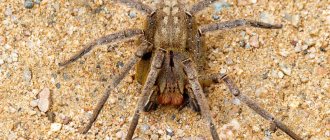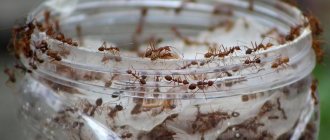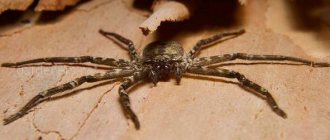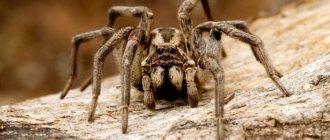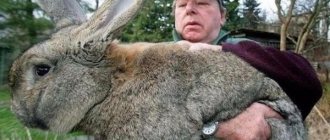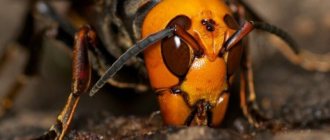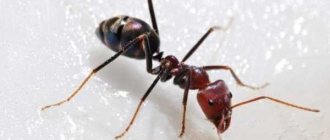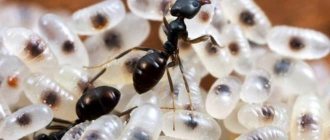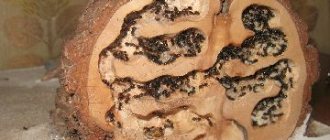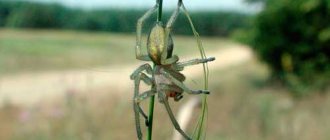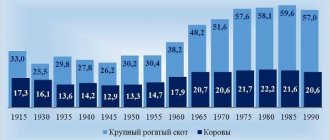General introduction to ants
From a biological point of view, ants belong to the Hymenoptera. Their size varies depending on the type. These are social insects that live in colonies. They build their anthills from small particles in the soil or wood. These families are well organized and have good communication systems to ensure that all their actions are coordinated. Interestingly, some species of ants communicate in their own language, with the help of which they convey complex information. Most of them have symbiotic relationships with certain insects, plants, fungi and bacteria.
Each member of the colony knows their place and clearly fulfills their assigned role.
- Females. These are the founders of the anthill. In most colonies there is only one female. She lays eggs so that her anthill constantly grows and replenishes.
- Males. They are needed for fertilization of females.
- Working individuals. Thanks to them, the anthill lives. They build a house, guard it, clean it, supply all the inhabitants with food, and take care of the larvae.
It is worth noting that males and females are equipped with wings, but worker ants do not have them. Also, some types of ants have a sting.
Only a third of the ants in the anthill are useful
It would be a mistake to assume that the entire anthill works in unison. In fact, about a third of the ants don't work. They simply parasitize, living at the expense of others and doing nothing. The other third behaves even worse: they are actively engaged in... useless things. For example, they dig a tunnel that leads to nowhere. And the last third - the one from which the anthill lives - feeds the first, corrects the mistakes of the second and manages to do all the necessary actions to maintain the life of the entire colony.
Photo: Sandeep Handa/Pixabay
Lifestyle
After the female has been fertilized, she loses her wings and goes in search of a place where she will lay the foundation of her anthill of several rooms and lay eggs there. The male never survives. The queen feeds the larvae with saliva. The first “batch” of emerging workers begins to engage in construction and food production. After enough worker ants appear, the female only lays eggs, and the colony takes care of the larvae (white, helpless worms). After five molts, pupae form and stop feeding. Adult females and workers emerge from them. This process lasts throughout the growing season. Males are reborn only in spring.
The main diet is plant juice from aphid secretions. But at the moment when they take care of the larvae, the ants feed on other insects.
How much weight does an ant lift?
Today it has been verified that on average an ant lifts a weight that is 50 times greater than its own - for example, each working leaf-cutter ant carries up to 100 mg. Knowing how much an ant weighs, you can calculate what it is capable of, like a weightlifter.
It is also useful to read: About red forest and house ants, as well as their differences
Interestingly, the soldiers of leaf-cutter ants weigh several dozen times more than ordinary workers, and the queen weighs 700 times more! Naturally, in this species, soldiers appear only in those anthills whose number exceeds 100 thousand individuals - it is difficult for a smaller number of workers to feed such an army.
In principle, a soldier of this type could set a more outstanding record, but he never does this: his task is not to carry loads, but to protect the “loaders.”
On a note
If a person could lift weights in the same proportions as ants do, he could easily press a barbell over his head up to 5 tons. That is, the strength of an ant is approximately 25 times greater than that of a human. As mathematicians cleverly calculated, it would take about a million ants to carry an adult, and about 10 thousand to carry a glass of beer. Of course, the results of such measurements depend on the type of ant and how much each of them weighs.
Of course, the smaller the ant, the less mass it lifts. However, the ratio of the weight lifted to the mass of the ant itself increases as the size of the insect decreases.
This is interesting
When carrying heavy loads together, the ants' abilities increase even more. During laboratory experiments, an ant alone developed a power of 24.2 erg/sec, and two ants together developed a power of 63.2 erg/sec. That is, an ant can lift as much in cooperation with a comrade as they both cannot lift on their own combined.
Why are ants so strong?
It must be said that not only ants are so strong: in general, all insects can develop very great power. The same fleas very quickly push their body over a distance 150 times their body length. And scarab beetles can lift up to 850 times their body weight. In front of such abilities, even the strength of an ant does not seem that great.
The reason for such phenomenal abilities of ants and insects in general has long been explained by scientists. In the animal world, there is a law according to which, when the geometric dimensions of the body of a living creature decrease, its mass decreases in proportion to the length of the body to the third power, and the cross-sectional area of the muscles decreases in proportion to the square of the body length.
It's a little complicated, but this means that ants have muscles 100 times stronger per unit mass than humans. And this proportion is also observed for other living beings - crustaceans, fish, mammals. And in addition, the exoskeleton and a slightly different muscle structure bring their own premiums into these calculations.
In general, this does not mean that the smallest ant is the strongest. Indeed, a tiny pharaoh ant lifts a weight that is many times greater than the weight that a giant wandering ant lifts. But the absolute mass of the load in the case of a domestic pest is less. Therefore, the strongest ant is precisely the largest.
It is also useful to read: What do ants eat?
Ants: species in Russia and their characteristics
It is known that these insects are able to adapt to various conditions and colonize any landscape. But each individual species has its own characteristics, and this is connected not only with external characteristics. Each of them has their own differences in behavior and lifestyle. Therefore, if we learn more deeply about these insects, even those that live on our territory, they may seem no less interesting to us than those that live only in the tropics. It has already been mentioned how many species of ants there are in the world, so it is worth noting that more than 125 species of them are found in Russia. But in different sources this figure varies and sometimes reaches 300. The most familiar of them are red forest, meadow, pharaoh, house, termites, leaf cutters and others. Let's look at some types of ants. Photos of some insects will be included.
How many ants does it take to lift different objects?
Knowing the weight of the ant and how much this hymenoptera can lift, the following calculations are made:
- 450 thousand ants can lift one adult man;
- a bag of potatoes (50 kg) is enough for 300 thousand ants;
- A bottle of juice (500 ml) will raise 3 thousand insects.
The strength of ants comes in handy when they need to adapt to difficult environmental conditions. The objects they come into contact with are most often much larger than the insects themselves. For them, even an ordinary leaf from a tree turns out to be a big burden. If an object has a complex shape and the ant cannot lift it, then it is able to drag it along for a long time.
If a person were endowed with such strength, he would lift about 4-5 tons without any problems. But no one is capable of lifting so many tons. This allows us to conclude that the strength of an ant is many times greater than that of a human. Many people are simply perplexed as to why such insects are endowed with such an ability.
Red forest
For its habitat, this species chooses mixed, coniferous and deciduous forests that are more than 40 years old. Females and workers are distinguished by their red-brown color. Their length is approximately 7-14 mm. The head of this ant is oblong and the body is dense. Males are black, with reddish or yellowish legs. Their families are single, divided into three castes. One nest can contain from 800 thousand to 1 million individuals. Mating flights begin from May to the end of June. The surprising thing is that only workers, males or females emerge from the eggs. It all depends on the needs of the family.
This type of ant can harm fruit trees due to the fact that they breed aphids. But at the same time they also benefit the gardens. These insects destroy many pests that cause damage to crop plants. At the same time, ants pay special attention to those insects in which mass reproduction begins. It has been calculated that in a large anthill these insects can bring up to 21 thousand pest pupae in one day. Therefore, one such anthill is capable of protecting approximately a hectare of coniferous forest.
Popular message topics
Quite often in nature there is such an animal as a fox. Representatives of this species live in North America, Europe, North Africa and even Asia. The fox is classified as a mammal. Despite its small size,
Taurus is a fairly large constellation. It is located between Gemini and Aries. Its area in the sky is 800 square degrees, among all other constellations it occupies the 16th position in size.
Source
meadow ant
Another species common in Russia is the meadow. The size of this insect varies between 5-11 mm. Meadow ants have a body covered with villi and a dark spot on the front of the chest. To build a house, they choose meadows, open edges and clearings. This species also breeds aphids. From the anthill to their “pastures” there are deepened paths, over which there are canopies. Ants walk along these paths for years. In addition to aphid secretions, these ant species feed on dead insects. They very rarely feast on live ones.
After winter, as soon as the air warms up to +10 degrees, they crawl out of the anthill. At a temperature of +30, insects do not leave their home. It was described above how many species of ants there are in the world, but of all of them, only these fly out to reproduce twice a season. They fall in May and August.
What does an anthill look like from the inside?
Anthill
It only looks like a bunch of twigs and needles, but inside there is a whole “ant city”. Inside, an underground gallery leads to chambers that are interconnected. The depth of the nests varies from 30 cm to 2 m, and in desert ants it reaches more than 10 m.
Interesting materials:
How often can you bathe your Labrador dog? How often can I use Capsicam? How often can you put your baby to the breast? How often can you take bifidumbacterin? How often can I take Escapelle tablets? How often can Lipolitics be used? How often can you use antiviral suppositories? How often should you change your electric toothbrush? How often should the cartridge be changed in the field? How often should you change kitchen towels?
Pharaoh ant
This representative is one of the smallest ants.
Their total length is 2-4 mm. They were first discovered in Egypt in tombs on mummies. Then Carl Linnaeus described them and gave them a name. This happened in 1758. Their small size helped these babies spread throughout the earth. They were spotted in Russia in 1889. This is how these types of ants gained fame. In the world they are found in almost every corner where there are people. They are usually yellow in color and have a dark belly. Males are almost black and always winged. This species is very hardworking, and in the northern side they live exclusively in human houses. They prefer darkness and moisture, so they are more often found in cracks in floors, walls and other voids. Because they are always warm, they do not hibernate and their colonies are constantly growing. Usually their number is several thousand. In addition, they do not have to fly out to reproduce, and after fertilization, the workers bite off the wings of the queen. In just a year, the family grows by two thousand inhabitants. The nest is divided, and so they spread throughout the entire area, growing into huge colonies. It is difficult to fight them, since there may be more than one female in one place. Interestingly, bedbugs cannot get along with these inhabitants, since the acids that come from pharaoh ants are fatal to these bed pests.
Option No. 3 Report about Ants
The world of insects is so diverse that every year people make more and more discoveries for themselves, getting acquainted with new species of representatives of this part of wildlife and their activities.
Of great interest among them are small, restless ants, whose lifestyle also interests children. Ants live in groups, as it is very difficult for them to cope with difficulties alone. The family size can range from several tens to millions of insects. Far from their group, their life expectancy decreases. This is due to an increase in the activity and performance of a solitary ant. Performing more movements alone, due to fatigue, his strength becomes less, and the time of their existence is reduced.
A large number of ant species are distributed everywhere. They are able to tolerate any climate zone, with the exception of severe cold and hot deserts.
Like any insect, ants prefer to have a cozy corner where they can always return. Their home is called an anthill. The favorite place for its construction is rotten wood, which looks like a heap or mound. There are countless passages inside the home, and the required temperature regime is also maintained there. Some of them find a place under stones and can fearlessly live in plain sight of people.
All this speaks about the nature of ants, which are capable of different types of activities. The efficiency of insects surprises both children and adults. The moments of movement of an ant with a burden larger than the insect itself become a close subject of attention. They are friendly among their relatives, each of whom has their own responsibilities.
The external color characteristics of this insect are varied. They are characterized by shades of yellow, black, and brown. The size of the ant is small, 2-3 millimeters.
Its structure is represented by three parts. Head with large eyes and antennae. There is a thin waist between the abdomen and chest. Thin, seemingly fragile, ant legs are protected by claws. With their help, he tenaciously grabs the found object and carries it. In addition, they facilitate easy upward movement.
Nature has endowed the small creature with a way to protect itself from the enemy: it uses formic acid, which it sprays out with special glands that are poisonous.
The residence of some species of ants near humans causes some harm to garden plants, spreading aphids, which are sometimes very difficult to rid plantings of. However, by eating some garden pests, they save the harvest. They are sought after by some bird species as food, for example, woodpeckers and wood grouse. In the steppes they disperse various seeds, from which snowdrops, violets, and celandine appear. In the process of building their home, thousands of insects simultaneously loosen the soil, the quality of which noticeably improves, and it becomes suitable for planting.
Human health is also sometimes subject to undesirable effects. This is due to the fact that insects become unexpected visitors to the house. With their presence they spoil food and are carriers of diseases. Known all over the world, “formic alcohol” is a cure for people’s ailments (asthma, diabetes).
Having enough information about ants, you can learn to understand their methods of survival, have an idea of their activities, and what danger they pose. Such knowledge teaches how to treat these insects correctly.
1st, 2nd, 3rd, 7th grade, the world around us briefly. In biology
House ant
These representatives are also among the smallest, their size ranges from 1 to 3 mm. The female and male are dark brown in color, and the working individuals are distinguished by their bright yellow color. These ants are called thieves. Their small size makes them almost invisible, and thanks to this they get along well near the anthills of other species. At the same time, they steal larvae and eggs from them in order to feed themselves. They can be found in central Russia, as well as on the southern side of the European part of the country.
Why are ants so powerful?
Zoologists readily explain why an ant or a beetle lifts more than its weight. The secret is that small living things, relative to their size or mass, have more muscle fibers than large animals. The same applies to humans.
Scientists have developed a formula to calculate the thickness of muscle fibers in proportion to body weight and size. And also the structure of Hymenoptera differs markedly from the skeleton of vertebrates and the set of their internal organs. When calculating how much weight an ant or other insect can lift, such anatomical features must be taken into account.
Since insects are very small, they join forces to carry objects that are huge for them. In Hymenoptera, a synergistic effect is often at work.
Two working members of a caste together are able to lift and carry more weight than if both carried separately. As a result of the combination of these two forces, productivity increases noticeably.
black ant
This species is also one of the most common and often settles in human homes. Their color is usually black, but can be dark brown. The entire body of the insect is covered with small villi. Usually anthills are built in the soil, and there is a mound on top. They can also build their homes in wood and under boulders. Sometimes you can find a larger black ant - in this case, you have stumbled upon another representative, it is called the reaper. This species is known for its tendency to store huge reserves in the anthill. They can collect about a kilogram of seeds and insects to successfully overwinter. It is interesting that, unlike other ants, they feed their larvae with plant food, and not insects.
But the types of ants that are found in Russia do not end there. For example, many people know wood borers that run along branches and collect honeydew on leaves, and establish their colonies in stumps or under the bark, gnawing passages. Also in the country there are some species of “Amazons” that do not give birth to workers, but steal larvae from more peaceful ants. The babies that are born think that the Amazons are their parents and begin to do all the “dirty” work for them.
What other abilities do they have?
Ant power, which never ceases to amaze the human imagination, is expressed not only in how many loads this insect can lift. Ants are also very inventive, and they also have other incredible abilities.
Hymenoptera put a lot of effort into caring for their offspring. The safety of future generations is their priority.
Insect bridges
African ants not only amaze with the amount of load they carry, but also with their ability to build living bridges. If they encounter a water obstacle, the working individuals quickly construct a bridge from their own bodies. This allows the queen and larvae to safely cross to the other side.
Visually, the bridge design looks very unusual. It's amazing how many Hymenoptera create it. Several hundred ant individuals at once firmly adhere to each other. In this position they maintain a static position until all the larvae and the queen are safely away from the water.
Dragging along the ground
No matter how much weight an ant is able to lift, this is not always possible due to the awkward shape of the object, so they often simply diligently drag their find along the ground. Also, the need for this may arise when an insect finds an object that is too large, which, even if it wants to, cannot be lifted above itself.
Scientists say that if we continue to study how much weight an ant can lift , as well as its other features, then in the future this will help design equipment and robots. Such innovative developments will make it possible for products to easily lift weights that will be many times greater than their own weight.
The most dangerous types of ants: names and descriptions
There are two types of these insects that instill special fear in humans. But they are not found in Russia. These are the bullet and soldier ants (also known as wandering ants). The first species is found in forests stretching from Paraguay to Nicaragua. Its body length is 2.5 centimeters. He makes his anthill on a tree. Passing under it, you can get caught by this ant, which bravely jumps on a person to protect its colony from the enemy. These insects can scream and, before attacking, they make a call. It's called a "bullet" for a reason. Its bite is as piercing and painful as a bullet wound.
Other facts about ants
The ants not only surprise scientists with how much they lift, despite their low weight, but also with a built-in pedometer and compass. During their walks, desert ants count their steps and keep track of how far they have gone. They do not have the ability to use markers on the ground, but still accurately find their way home.
Anthills provide for a rational division of labor. During its life, each individual tries new roles in turn: takes care of the offspring, builds a nest, collects food.
Some ant nests harbor molds. In addition, these gardeners milk aphids. However, this is not considered parasitism, since the aphids live longer thanks to the care of the Hymenoptera.
Ants are the famous weightlifters among insects. The ratio of the total mass of these hymenoptera and people is constantly changing, but definitely not in favor of the former. This is due to the process of increasing the role of cities and other factors. Considering how much weight an ant lifts that is disproportionate to its mass, one can only imagine its ability to survive in the wild.
Soldier Ant
This is the second dangerous arthropod. It mainly lives in the Amazon, but its families can be found in Asia and Africa. These are large individuals, reaching 1.5 cm. They are also equipped with large mandibles (approximately 7-8 mm). These ants do not have a permanent anthill. They always roam, stopping only for that short period while the queen lays eggs. At this time, the soldiers are in search of food. When the larvae appear, the ants pick them up and continue on their way. The worst thing is that on their way they destroy all living things - insects, small and large animals - all those who did not want to hide or fell asleep. Hundreds of thousands of powerful soldiers cover the unwary victim like a wave. These ants are completely blind, so they regard everything as a threat to their colony. That is why they are not afraid of the size of animals.
These ants are an unusually united people. If necessary, they can create absolutely any shape from their bodies. For example, they make bridges to help the colony overcome obstacles, or walls to protect against bad weather. To do this, they cling tightly to each other.
Exotic species
Unlike Russian ones, exotic species are often dangerous to people and have unusual behavior. Let's look at some of the brightest representatives of foreign ants.
Bulldog Ants
This genus of ants got its name because of its characteristic, menacing-looking jaws. In total it includes about 90 species. Bulldog ants live in Australia. Also one species is found in New Caledonia and New Zealand.
Myrmecia pavida Clark, one of the varieties of the bulldog ant, can instantly jump 39 cm or jump up to 7.6 cm.
Bulldogs have large, protruding eyes. Most species have an impressive size - up to 3 cm. The color of ants is varied, usually they are black, brown, or bright red or orange. Able to jump, which is rare in the ant family; Besides bulldogs, three more genera are capable of this. Bulldogs live in earthen nests; only one arboreal species is known. There is usually only one queen and she lives for two years.
According to statistics, 3% of people stung by bulldog ants develop a severe allergic reaction
Bulldog ants contain gamergates—working individuals that are capable of reproducing in the event of the death of the queen.
These ants are predators and feed on insects, including wasps and bees. They can also consume sweet plant juices. Some species have an interesting feature - they produce eggs intended exclusively for feeding. Insects are quite dangerous for humans: the bite of some species can cause severe pain, which only goes away after a few days. There have been cases of death due to severe allergic reactions to bulldog ant venom.
Leafcutter ants
Leaf cutters are a large group of ants, including 15 genera. All species vary in color and size, but rarely reach more than 2 cm in length. Leaf cutters live on the American continents; in North America - in the southern USA. Capable of a kind of agriculture, growing mushrooms in anthills.
Scientists have found that some types of leaf-cutter ants, when growing mushrooms, even add fertilizer to the leaf substrate
Leaf cutters got their name because they cut leaves and flowers, which they then take to the anthill. However, they do not eat them, but only chew them, thus creating nutritious soil for growing mushrooms. During their existence, mushrooms and ants formed a symbiosis, and young queens, organizing a new nest, immediately bring spores and hyphae of the fungus into it. Anthills can extend over tens of cubic meters along the ground, and their above-ground part consists of mounds reaching a meter in height. The size of the colony is up to 8 million ants, headed by one queen.
Leafcutter ants are one of the strongest creatures on Earth, as they can lift loads that weigh 50 times their weight.
These ants are safe for humans, since they themselves do not attack humans. And the poison of this insect is not as strong as, for example, that of a bulldog. But if a person is prone to allergies, individual reactions and redness may be observed after the bite. Why leaf cutters are dangerous is for the garden - if attacked by ants overnight, only bare trunks may remain.
Ant bullet
The most dangerous representative of the ant family is the bullet ant. Its venom is recognized as the most toxic of all known insect venoms.
The ant received the name “bullet” for its impressive sting (up to 3.5 mm) and the acute pain from the bite, comparable to the sensations from a bullet wound. Another name is ant-24 hours, since the pain lasts about a day.
These insects are found in the tropical rainforests of Central and South America. The size of the bullet ant is 1.8–2.5 cm, the color is brown-black. There are 1–3 thousand individuals living in a colony; there may be one or several queens. Anthills are usually located in the soil, at the roots of trees, and in some cases on the trees themselves. Bullet ants feed on live and dead insects, and sometimes even small vertebrates, which they cut into pieces with sharp jaws and carry to the anthill. However, they are not aggressive towards large creatures, and will only attack humans if they feel threatened.
To avoid being attacked by a bullet ant, it is better not to approach it.
In a dangerous situation, the ant begins to make hissing sounds and secrete repellent musky substances. If this does not help, it attacks the threatening object with its stinger. Since bullet venom is a neurotoxin, it causes local paralysis and extremely severe pain, which is 30 times worse than the pain of a wasp sting and lasts about 24 hours. Severe allergic reactions often occur, including anaphylactic shock, so deaths as a result of a bite are not uncommon if medical attention is not provided in time. Based on the above, the bullet can be considered the most dangerous ant for humans.
Many Indian tribes use bullet ants to initiate young men into adult men. While undergoing initiation, a young man must hold mittens with ants woven into them for 10 minutes.
Red fire ants
Another deadly ant is the red fire ant. Its venom, like that of the bullet ant, is very toxic. The homeland of the species is Brazil, although with the advent of transport they spread to other countries with warm climates. Now they can be found in Australia, New Zealand, USA, and China.
This type of ant is very aggressive and is capable of destroying most living creatures in the territory they inhabit. They are omnivores, so they sweep away both animals and plants in their path.
Red fire ants are small, measuring 2–6 mm. The body is reddish-brown. Their anthills are earthen, up to half a meter high. A colony can have one or several queens.
Red fire ants are extremely dangerous to people and ecosystems
These ants got their name “fire” because of the burning sensation at the site of their bites. It is better not to approach their anthill at all, because when the colony is threatened, the insects attack all at once, even large creatures - animals and people. But their poison is very dangerous, and if a person is prone to allergies, then an attack by even one ant can be fatal.
More than 30 people die from fire ant bites in America every year.
Red fire ants also harm agriculture by destroying crops and attacking domestic animals. Once these insects are infested in homes, they are very difficult to remove, which is why residents usually choose to move out for their own safety.
Army ant soldiers
Worker ants of different species are usually called soldiers, but there is also a separate species with this name. Army ant soldiers are nomads that are found in the Amazon, Asia and Africa. Adults are approximately 1.5 cm in size and have a dark red body color. The queen during the ovipositor period reaches 5 cm, which is why army ants can be considered the largest in the world.
Another name for the species is Siafu nomadic ants.
They were nicknamed army because of their behavior, because the entire colony, which can reach a million individuals, coordinates its actions like a battalion of soldiers. They do not have permanent nests, and they are on the move all their lives, stopping only for the period of reproduction. When the queen lays eggs and the larvae emerge, the ants continue on their way.
The army soldier ant looks very combative thanks to its tenacious jaws
Ants build a temporary home with their bodies, interlocking with each other with their jaws and forming a spherical structure.
They destroy any living creature they encounter. A distinctive feature is that the soldiers are blind, so they attack everyone indiscriminately, and can tear apart an animal the size of a horse. This makes them extremely dangerous, including for people. But the bites of individual soldiers themselves do not pose a threat to life, although they can cause allergies; no deaths were recorded from them.
Honey ants
A large group of ants, including 5 different genera, are called honey ants. The name is associated with an interesting feature: some working individuals store large reserves of honeydew and plant juice in their abdomens. This is how the ants adapted to the arid climate of the deserts and semi-deserts where they live. There are few plants and aphids, the secretions of which the ants feed on, so the inflated “honey barrels” feed other individuals as needed. Insects often swollen from honeydew are unable to move, so they hang in the upper part of the anthill chamber.
An ant's abdomen filled with honeydew becomes larger in size than it is.
Mexicans call the “ant barrels” of Myrmecocystus “earth grapes” and extract honey from them. Almost 400 grams of honey are “squeezed” out of 1000 barrel ants.
One colony of honey ants can contain from hundreds to several million individuals, led by a queen. There can be a thousand or more thrifty “honey barrels”; a colony with 1,500 such worker ants has been recorded.
Yellow crazy ants
The species Anoplolepis gracilipes has an unusual name - these ants were called crazy for their chaotic behavior. They are yellow-brown in color, have long legs and a body measuring about 4mm.
Yellow crazy ants can spread around the world using human transport. It is believed that they appeared in Africa, but later settled on the islands of the Pacific and Indian Oceans.
Their social structure is interesting: several colonies unite into a supercolony, similar to a federation. Each of its components has its own workers and its own queen, but they do not compete, but cooperate with each other, which helps the species to more successfully capture new territories.
A yellow crazy ant caused an environmental disaster in the Seychelles by attacking a palm forest
Yellow ants feed on insects, plants, including grain. They can also eat small invertebrate animals, like many predatory species. For people who are not prone to allergies, crazy ants are not very dangerous, although their bites are quite unpleasant and cause itching and swelling due to the venom. But these insects pose a serious threat to ecology and agriculture.
On Christmas Island, yellow crazy ants have killed 15-20 million red crabs - 30% of the entire population - since 1989.
Enemies of ants
As we have seen, different types of ants have their own internal structure, which protects them and allows the colony to exist. But these insects also have enemies who love to feast on them. One of the largest ant pests is the bear. He regularly destroys anthills by putting his paws there. The ants “stick around” them, and the bear licks the treat. Moles and frogs also like to snack on these insects; they will not let a baby run past. In addition, many people know the animal called “anteater”. Its muzzle is specially adapted to fit into the homes of insects. In addition, he is not afraid of their bites, since the fur is so hard and thick that even small ants are not able to get through it. The meat of this animal smells very much of these insects and is black in color. But these are not the only enemies of ants, since they are hunted not only by mammals, but by birds and even fish.
Ant lifting capacity
Information about how much weight an ant can lift can greatly surprise a person’s imagination. Entomologists claim that this representative of the Hymenoptera lifts a weight that is 50 times greater than its own body weight. A good example is the leaf cutter. Knowing his weight, it is assumed that it is not difficult for him to bear weights that reach 100 mg.
But not only these ants have this ability. Representatives of another group of insects can also set similar records. Many Coleoptera push and pull loads that are many times their own weight. Orthoptera or blood-sucking parasites jump long distances. It is also a type of weight transfer because jumping requires you to lift your own body weight off the ground.
The leader in carrying heavy loads is the scarab beetle (dung beetle) . He lifts a weight almost a thousand times greater than his body weight. This is compared to what it would be like for a person to lift 6 double-decker buses at the same time.
